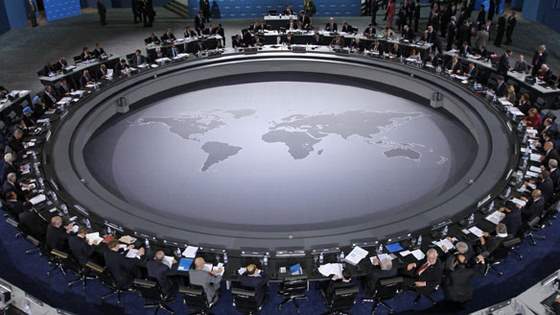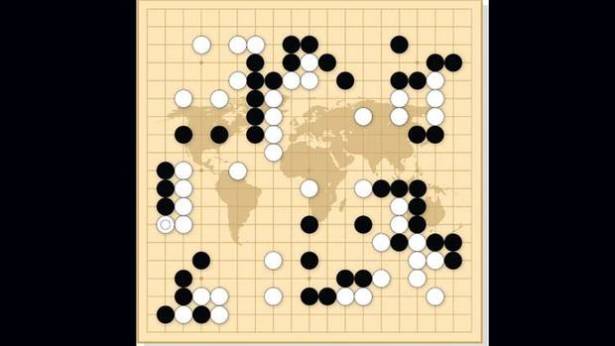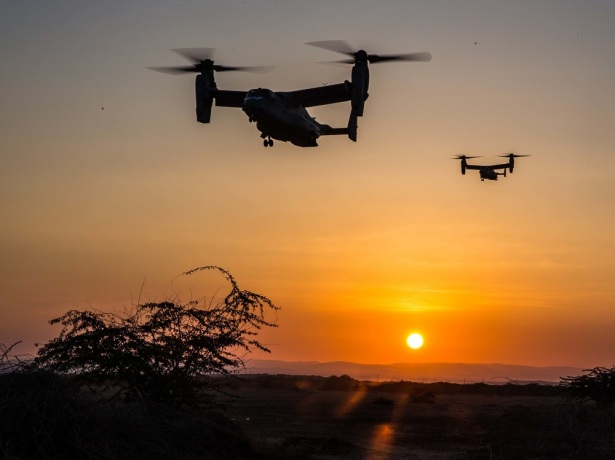
US Marine exercise in Djibouti, January 2017 Image credit: US Marine corps
Secret U.S. Military Documents Reveal a Constellation of American Military Bases Across That Continent
by Nick Turse
General Thomas Waldhauser sounded a little uneasy. “I would just say, they are on the ground. They are trying to influence the action,” commented the chief of U.S. Africa Command (AFRICOM) at a Pentagon press briefing in March, when asked about Russian military personnel operating in North Africa. “We watch what they do with great concern.”
And Russians aren’t the only foreigners on Waldhauser’s mind. He’s also wary of a Chinese “military base” being built not far from Camp Lemonnier, a large U.S. facility in the tiny, sun-blasted nation of Djibouti. “They’ve never had an overseas base, and we’ve never had a base of… a peer competitor as close as this one happens to be,” he said. “There are some very significant… operational security concerns.”
At that press conference, Waldhauser mentioned still another base, an American one exposed by the Washington Post last October in an article titled, “U.S. has secretly expanded its global network of drone bases to North Africa.” Five months later, the AFRICOM commander still sounded aggrieved. “The Washington Post story that said ‘flying from a secret base in Tunisia.’ It’s not a secret base and it’s not our base… We have no intention of establishing a base there.”
Waldhauser’s insistence that the U.S. had no base in Tunisia relied on a technicality, since that foreign airfield clearly functions as an American outpost. For years, AFRICOM has peddled the fiction that Djibouti is the site of its only “base” in Africa. “We continue to maintain one forward operating site on the continent, Camp Lemonnier,” reads the command’s 2017 posture statement. Spokespeople for the command regularly maintain that any other U.S. outposts are few and transitory — “expeditionary” in military parlance.
While the U.S. maintains a vast empire of military installations around the world, with huge — and hard to miss — complexes throughout Europe and Asia, bases in Africa have been far better hidden. And if you listened only to AFRICOM officials, you might even assume that the U.S. military’s footprint in Africa will soon be eclipsed by that of the Chinese or the Russians.
Highly classified internal AFRICOM files offer a radically different picture. A set of previously secret documents, obtained by TomDispatch via the Freedom of Information Act, offers clear evidence of a remarkable, far-ranging, and expanding network of outposts strung across the continent. In official plans for operations in 2015 that were drafted and issued the year before, Africa Command lists 36 U.S. outposts scattered across 24 African countries. These include low-profile locations — from Kenya to South Sudan to a shadowy Libyan airfield — that have never previously been mentioned in published reports. Today, according to an AFRICOM spokesperson, the number of these sites has actually swelled to 46, including “15 enduring locations.” The newly disclosed numbers and redacted documents contradict more than a decade’s worth of dissembling by U.S. Africa Command and shed new light on a constellation of bases integral to expanding U.S. military operations on the African continent and in the Middle East.

A map of U.S. military bases — forward operating sites, cooperative security locations, and contingency locations — across the African continent in 2014 from declassified AFRICOM planning documents (Nick Turse/TomDispatch).
A Constellation of Bases
AFRICOM failed to respond to repeated requests for further information about the 46 bases, outposts, and staging areas currently dotting the continent. Nonetheless, the newly disclosed 2015 plans offer unique insights into the wide-ranging network of outposts, a constellation of bases that already provided the U.S. military with unprecedented continental reach.
Those documents divide U.S. bases into three categories: forward operating sites (FOSes), cooperative security locations (CSLs), and contingency locations (CLs). “In total, [the fiscal year 20]15 proposed posture will be 2 FOSes, 10 CSLs, and 22 CLs” state the documents. By spring 2015, the number of CSLs had already increased to 11, according to then-AFRICOM chief General David Rodriguez, in order to allow U.S. crisis-response forces to reach potential hot spots in West Africa. An appendix to the plan, also obtained by TomDispatch, actually lists 23 CLs, not 22. Another appendix mentions one additional contingency location.
These outposts — of which forward operating sites are the most permanent and contingency locations the least so — form the backbone of U.S. military operations on the continent and have been expanding at a rapid rate, particularly since the September 2012 attack on the U.S. Mission in Benghazi, Libya, that killed U.S. Ambassador J. Christopher Stevens and three other Americans. The plans also indicate that the U.S. military regularly juggles locations, shuttering sites and opening others, while upgrading contingency locations to cooperative security locations in response to changing conditions like, according to the documents, “increased threats emanating from the East, North-West, and Central regions” of the continent.
AFRICOM’s 2017 posture statement notes, for example, a recent round of changes to the command’s inventory of posts. The document explains that the U.S. military “closed five contingency locations and designated seven new contingency locations on the continent due to shifting requirements and identified gaps in our ability to counter threats and support ongoing operations.” Today, according to AFRICOM spokesman Chuck Prichard, the total number of sites has jumped from the 36 cited in the 2015 plans to 46 — a network now consisting of two forward operating sites, 13 cooperative security locations, and 31 contingency locations.
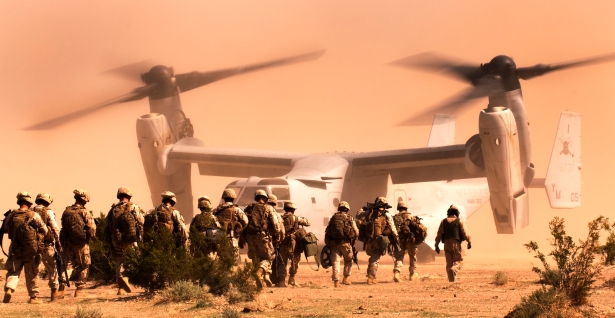
US marines boarding MV-22
Location, Location, Location
AFRICOM’s sprawling network of bases is crucial to its continent-wide strategy of training the militaries of African proxies and allies and conducting a multi-front campaign aimed at combating a disparate and spreading collection of terror groups. The command’s major areas of effort involve: a shadow war against the militant group al-Shabaab in Somalia (a long-term campaign, ratcheting up in the Trump era, with no end in sight); attempts to contain the endless fallout from the 2011 U.S. and allied military intervention that ousted Libyan dictator Muammar Qaddafi (a long-term effort with no end in sight); the neutralizing of “violent extremist organizations” across northwest Africa, the lands of the Sahel and Maghreb (a long-term effort with no end in sight); the degradation of the Islamist militant group Boko Haram in the Lake Chad Basin nations of Nigeria, Niger, Cameroon, and Chad (a long-term effort — to the tune of $156 million last year alone in support of regional proxies there — with no end in sight); countering piracy in the Gulf of Guinea (a long-term effort with no end in sight), and winding down the wildly expensive effort to eliminate Joseph Kony and his murderous Lord’s Resistance Army in Central Africa (both live on, despite a long-term U.S. effort).
The U.S. military’s multiplying outposts are also likely to prove vital to the Trump administration’s expanding wars in the Middle East. African bases have long been essential, for instance, to Washington’s ongoing shadow war in Yemen, which has seen a significant increase in drone strikes under the Trump administration. They have also been integral to operations against the Islamic State in Iraq and Syria, where a substantial (and deadly) uptick in U.S. airpower (and civilian casualties) has been evident in recent months.
In 2015, AFRICOM spokesman Anthony Falvo noted that the command’s “strategic posture and presence are premised on the concept of a tailored, flexible, light footprint that leverages and supports the posture and presence of partners and is supported by expeditionary infrastructure.” The declassified secret documents explicitly state that America’s network of African bases is neither insignificant nor provisional. “USAFRICOM’s posture requires a network of enduring and non-enduring locations across the continent,” say the 2015 plans. “A developed network of FOSes, CSLs, and non-enduring CLs in key countries… is necessary to support the command’s operations and engagements.”
According to the files, AFRICOM’s two forward operating sites are Djibouti’s Camp Lemonnier and a base on the United Kingdom’s Ascension Island off the west coast of Africa. Described as “enduring locations” with a sustained troop presence and “U.S.-owned real property,” they serve as hubs for staging missions across the continent and for supplying the growing network of outposts there.
Lemonnier, the crown jewel of America’s African bases, has expanded from 88 acres to about 600 acres since 2002, and in those years, the number of personnel there has increased exponentially as well. “Camp Lemonnier serves as a hub for multiple operations and security cooperation activities,” reads AFRICOM’s 2017 posture statement. “This base is essential to U.S. efforts in East Africa and the Arabian Peninsula.” Indeed, the formerly secret documents note that the base supports “U.S operations in Somalia CT [counterterrorism], Yemen CT, Gulf of Aden (counter-piracy), and a wide range of Security Assistance activities and programs throughout the region.”
In 2015, when he announced the increase in cooperative security locations, then-AFRICOM chief David Rodriguez mentioned Senegal, Ghana, and Gabon as staging areas for the command’s rapid reaction forces. Last June, outgoing U.S. Army Africa commander Major General Darryl Williams drew attention to a CSL in Uganda and one being set up in Botswana, adding, “We have very austere, lean, lily pads, if you will, all over Africa now.”
CSL Entebbe in Uganda has, for example, long been an important air base for American forces in Africa, serving as a hub for surveillance aircraft. It also proved integral to Operation Oaken Steel, the July 2016 rapid deployment of troops to the U.S. Embassy in Juba, South Sudan, as that failed state (and failed U.S. nation-building effort) sank into yet more violence.
Libreville, Gabon, is listed in the documents as a “proposed CSL,” but was actually used in 2014 and 2015 as a key base for Operation Echo Casemate, the joint U.S.-French-African military response to unrest in the Central African Republic.
AFRICOM’s 2015 plan also lists cooperative security locations in Accra, Ghana; Gaborone, Botswana; Dakar, Senegal; Douala, Cameroon; Ouagadougou, Burkina Faso; and Mombasa, Kenya. While officially defined by the military as temporary locales capable of being scaled up for larger operations, any of these CSLs in Africa “may also function as a major logistics hub,” according to the documents.
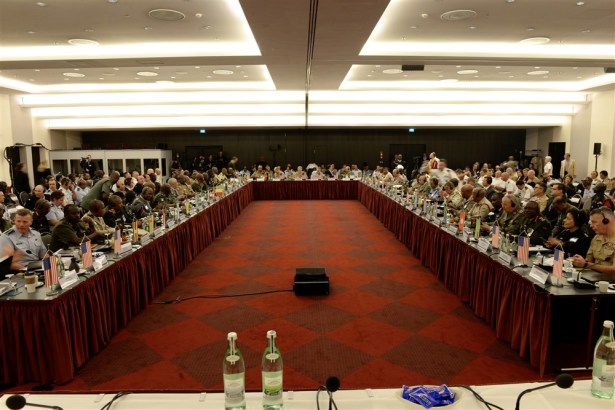
More than 40 African Chiefs of Defence or their representatives participated in the first ever CHoD conference hosted by U.S. Africa Command, April 19-20, 2017, in Stuttgart, GE. Countering VEOs and peace support operations were the central topics for discussion. (Photos by Brenda Law and Staff Sgt. Grady Jones, U.S. AFRICOM Public Affairs/Released)
Contingency Plans
The formerly secret AFRICOM files note that the command has designated five contingency locations as “semi-permanent,” 13 as “temporary,” and four as “initial.” These include a number of sites that have never previously been disclosed, including outposts in several countries that were actually at war when the documents were created. Listed among the CLs, for instance, is one in Juba, the capital of South Sudan, already in the midst of an ongoing civil war in 2014; one in Bangui, the capital of the periodically unstable Central African Republic; and another in Al-Wigh, a Saharan airfield in southern Libya located near that country’s borders with Niger, Chad, and Algeria.
Officially classified as “non-enduring” locations, CLs are nonetheless among the most integral sites for U.S. operations on the continent. Today, according to AFRICOM’s Prichard, the 31 contingency locations provide “access to support partners, counter threats, and protect U.S. interests in East, North, and West Africa.”
AFRICOM did not provide the specific locations of the current crop of CLs, stating only that they “strive to increase access in crucial areas.” The 2015 plans, however, provide ample detail on the areas that were most important to the command at that time. One such site is Camp Simba in Manda Bay, Kenya, also mentioned in a 2013 internal Pentagon study on secret drone operations in Somalia and Yemen. At least two manned surveillance aircraft were based there at the time.
Chabelley Airfield in Djibouti is also mentioned in AFRICOM’s 2015 plan. Once a spartan French Foreign Legion post, it has undergone substantial expansion in recent years as U.S. drone operations in that country were moved from Camp Lemonnier to this more remote location. It soon became a regional hub for unmanned aircraft not just for Africa but also for the Middle East. By the beginning of October 2015, for example, drones flown from Chabelley had already logged more than 24,000 hours of intelligence, surveillance, and reconnaissance missions and were also, according to the Air Force, “responsible for the neutralization of 69 enemy fighters, including five high-valued individuals” in the war against the Islamic State in Iraq and Syria.
AFRICOM’s inventory of CLs also includes sites in Nzara, South Sudan; Arlit, Niger; both Bamako and Gao, Mali; Kasenyi, Uganda; Victoria, the capital of the Seychelles; Monrovia, Liberia; Ouassa and Nema, Mauritania; Faya Largeau, Chad; Bujumbura, Burundi; Lakipia, the site of a Kenyan Air Force base; and another Kenyan airfield at Wajir that was upgraded and expanded by the U.S. Navy earlier in this decade, as well as an outpost in Arba Minch, Ethiopia, that was reportedly shuttered in 2015 after nearly five years of operation.
A longtime contingency location in Niamey, the capital of Niger, has seen marked growth in recent years as has a more remote location, a Nigerien military base at Agadez, listed among the “proposed” CSLs in the AFRICOM documents. The U.S. is, in fact, pouring $100 million into building up the base, according to a 2016 investigation by the Intercept. N’Djamena, Chad, the site of yet another “proposed CSL,” has actually been used by the U.S. military for years. Troops and a drone were dispatched there in 2014 to aid in operations against Boko Haram and “base camp facilities” were constructed there, too.
The list of proposed CLs also includes sites in Berbera, a town in the self-declared Republic of Somaliland, and in Mogadishu, the capital of neighboring Somalia (another locale used by American troops for years), as well as the towns of Baidoa and Bosaso. These or other outposts are likely to play increasingly important roles as the Trump administration ramps up its military activities in Somalia, the long-failed state that saw 18 U.S. personnel killed in the disastrous “Black Hawk Down” mission of 1993. Last month, for instance, President Trump relaxed rules aimed at preventing civilian casualties when the U.S. conducts drone strikes and commando raids in that country and so laid the foundation for a future escalation of the war against al-Shabaab there. This month, AFRICOM confirmed that dozens of soldiers from the Army’s 101st Airborne Division, a storied light infantry unit, would be deployed to that same country in order to train local forces to, as a spokesperson put it, “better fight” al-Shabaab.
Many other sites previously identified as U.S. outposts or staging areas are not listed in AFRICOM’s 2015 plans, such as bases in Djema, Sam Ouandja, and Obo in the Central African Republic that were revealed, in recent years, by the Washington Post. Also missing is a newer drone base in Garoua, Cameroon, not to mention that Tunisian air base where the U.S. has been flying drones, according to AFRICOM’s Waldhauser, “for quite some time.”
Some bases may have been shuttered, while others may not yet have been put in service when the documents were produced. Ultimately, the reasons that these and many other previously identified bases are not included in the redacted secret files are unclear due to AFRICOM’s refusal to offer comment, clarification, or additional information on the locations of its bases.
Base Desires
“Just as the U.S. pursues strategic interests in Africa, international competitors, including China and Russia, are doing the same,” laments AFRICOM in its 2017 posture statement. “We continue to see international competitors engage with African partners in a manner contrary to the international norms of transparency.”
Since it was established as an independent command in 2008, however, AFRICOM itself has been anything but transparent about its activities on the continent. The command’s physical footprint may, in fact, have been its most jealously guarded secret. Today, thanks to AFRICOM’s own internal documents, that secret is out and with AFRICOM’s admission that it currently maintains “15 enduring locations,” the long-peddled fiction of a combatant command with just one base in its area of operations has been laid to rest.
“Because of the size of Africa, because of the time and space and the distances, when it comes to special crisis-response-type activities, we need access in various places on the continent,” said AFRICOM chief Waldhauser during his March press conference. These “various places” have also been integral to escalating American shadow wars, including a full-scale air campaign against the Islamic State in Libya, dubbed Operation Odyssey Lightning, which ended late last year, and ongoing intelligence-gathering missions and a continued U.S. troop presence in that country; drone assassinations and increased troop deployments in Somalia to counter al-Shabaab; and increasing engagement in a proxy war against Boko Haram militants in the Lake Chad region of Central Africa. For these and many more barely noticed U.S. military missions, America’s sprawling, ever-expanding network of bases provides the crucial infrastructure for cross-continental combat by U.S. and allied forces, a low-profile support system for war-making in Africa and beyond.
Without its wide-ranging constellation of bases, it would be nearly impossible for the U.S. to carry out ceaseless low-profile military activities across the continent. As a result, AFRICOM continues to prefer shadows to sunlight. While the command provided figures on the total number of U.S. military bases, outposts, and staging areas in Africa, its spokespeople failed to respond to repeated requests to provide locations for any of the 46 current sites. While the whereabouts of the new outposts may still be secret, there’s little doubt as to the trajectory of America’s African footprint, which has increased by 10 locations — a 28% jump — in just over two years.
America’s “enduring” African bases “give the United States options in the event of crisis and enable partner capacity building,” according to AFRICOM’s Chuck Prichard. They have also played a vital role in conflicts from Yemen to Iraq, Nigeria to Somalia. With the Trump administration escalating its wars in Africa and the Middle East, and the potential for more crises — from catastrophic famines to spreading wars — on the horizon, there’s every reason to believe the U.S. military’s footprint on the continent will continue to evolve, expand, and enlarge in the years ahead, outpost by outpost and base by base.
Nick Turse is the managing editor of TomDispatch, a fellow at the Nation Institute, and a contributing writer for the Intercept. His latest book, Next Time They’ll Come to Count the Dead: War and Survival in South Sudan, was a finalist for the 2016 Investigative Reporters and Editors Book Award. His website is NickTurse.com.
This article was first published at TomDispatch
